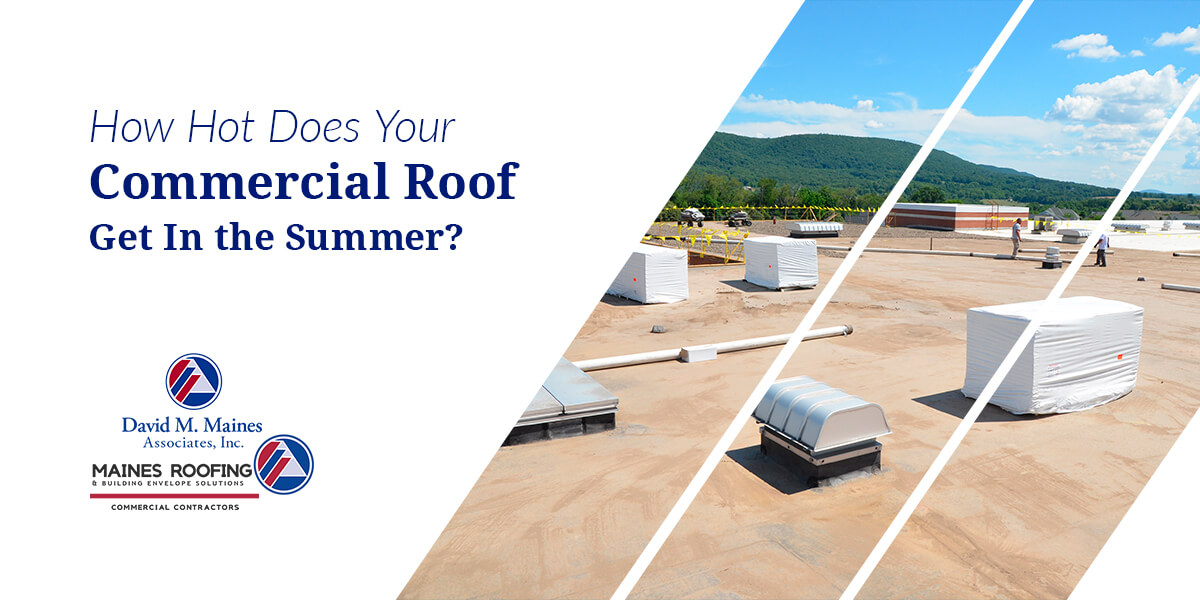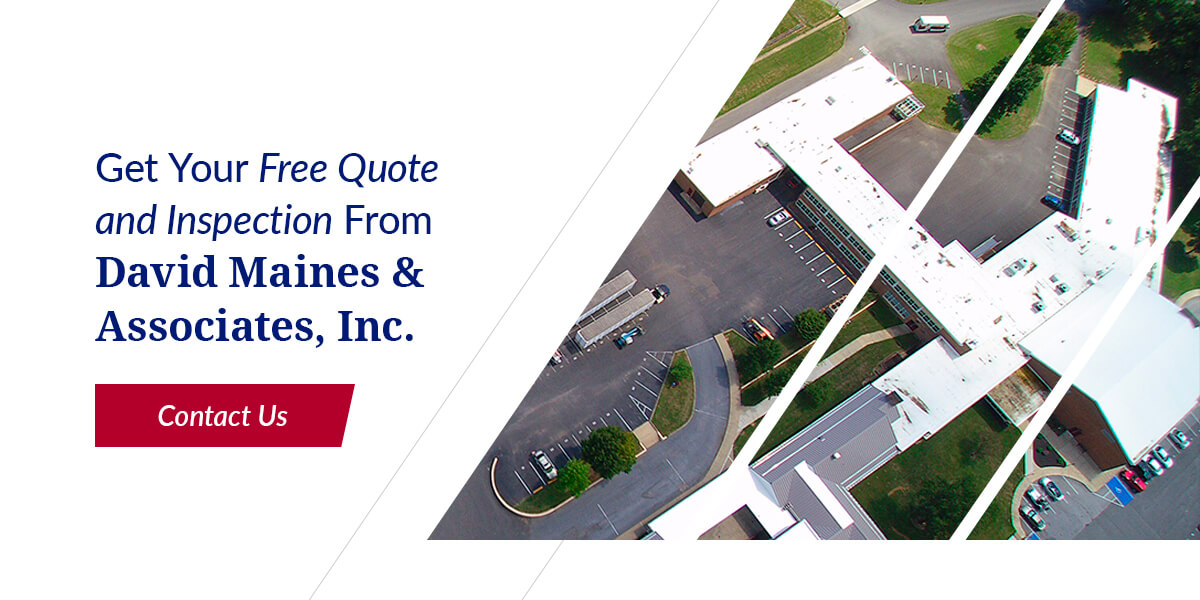Table of Contents
- Commercial Roof Max Heat
- Different Rooftop Styles
- Interior Temperatures
- Roof Temperatures
- Should You Get a New Roof?
- Get Your Free Quote and Inspection From David Maines & Associates, Inc.
Depending on your location and the materials used to build your building, summer weather can be unknowingly intense on your commercial roof. Have you personally been concerned with how hot your roof gets in the summer, or are you purely curious about the range of typical temperatures a commercial roof can reach? Many business owners will see different temperature spikes depending on the material and color of their commercial roof.
Much like the heat radiating from your car, heat can magnify and be more intense than you would think, depending on the car’s finish and interior choices. Below is information regarding different types of commercial roofing materials, the temperatures that come with each type and more so you can rest your mind knowing how hot your roof will get in the summer.
Commercial Roof Max Heat
Before we get into all the different types of commercial roofing and their pros and cons, let us talk about max potential heat. The darker the commercial roof is, the more heat it radiates from the sun like other materials. Darker rooftops can absorb nearly all of the energy reflecting off of them, creating anywhere between a 20-degree hike in temperature to approximately 90 degrees. Installing a commercial roof with the incorrect materials could lead to lower business production and hinder the efficiency of the building.
Knowing the suitable materials to use for the type of roof you need is vital. For example, if you use a vegetative rooftop, you will lower heat by providing shade and removing the heat from the air. Using these green rooftops can protect the building itself from the heat by delivering these dispersal qualities. These types of roofs also lower the heat island effect cities can experience.
Different Rooftop Styles
There are many forms of commercial rooftops for varying needs and budget sizes. Each type of roof handles heat in its way as well. We will cover the most common commercial roofing will, but we’ll list all roof types. Black roofing will always get the hottest as it retains the heat and even amplifies it. Black roofing could degrade faster than other types of roofing because of this, so typical local weather and the environment around the building need to be involved in the decision process.
There are a total of seven different commercial roofing materials.
- Metal roofing
- Built-up roofing membrane
- Thermoset EPDM roof membrane
- Thermoplastic PVC and TPO roof membrane
- Spray-on silicone
- Shingle roofing
- Green roofing
Metal Roofing
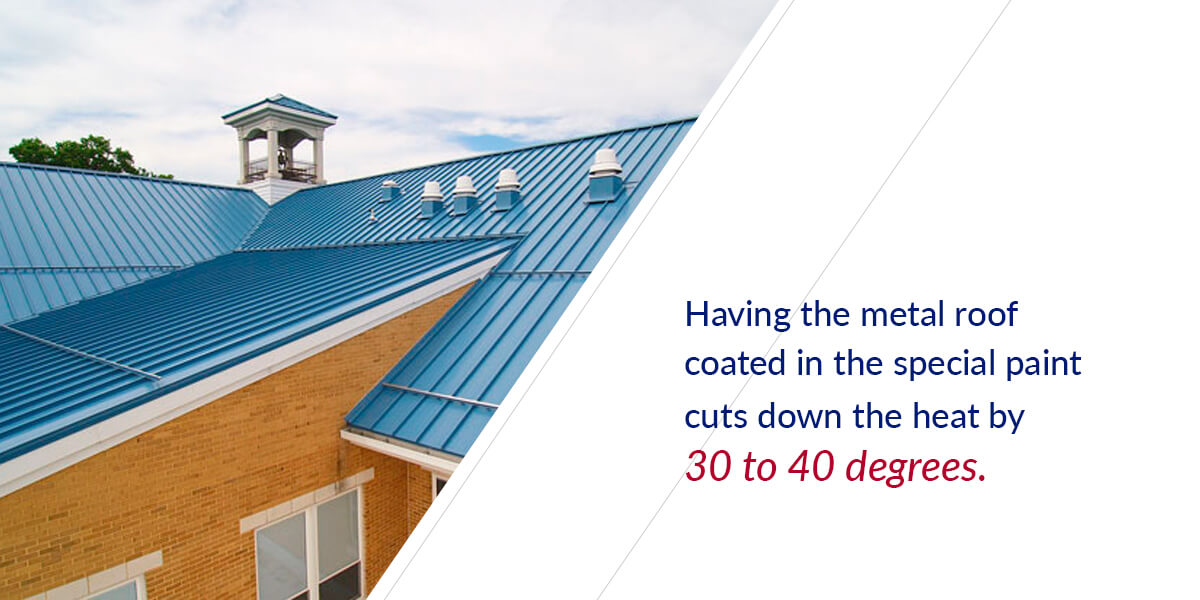
Metal roofing also heats up, so if you choose metal roofing, make sure to coat it with unique paint, called BASF cool paint, before installation. Even though the heat of a metal roof won’t reach as high as a black roof, it is typically scorching to the touch. Having the metal roof coated in the special paint cuts down the heat by 30 to 40 degrees. There are also many different types of metal roofing you can choose between.
Metal roofing is susceptible to rusting, so you need to install protective layering. Metal roofing also has a very high rating for fire safety and is more durable than other types of roofing. Metal roofing can also have an attractive look when done correctly. Increased sustainability for your building also comes with having a metal roof. Here are some metal types to choose from when considering metal roofing for your commercial business:
- Metal tile sheets
- Copper
- Aluminum
- Stainless steel
- Corrugated galvanized steel
- Silicone-coated steel
- Stone-coated steel
- Tin
- Lead
Thermoplastic Roof Membrane
A thermoplastic roof membrane is a lightweight roofing option. Thermoplastic roofing is reflective and protects against weathering. The highly reflective aspects of this type of commercial roofing help keep the heat down and protects your roof from UV lighting, punctures, chemicals such as oil and bacterial growth. Using white roofing such as this in hotter climates or areas is the best way to go based on the reflective aspects of the material. Instead of absorbing the heat like black roofing, it reflects it into the atmosphere.
Because of the resistance to chemicals such as animal fats and oils, this material is a superb choice for restaurants or other commercial businesses that deal with those types of chemicals going through their ventilation systems. There are two types of materials used for these roofs: Thermoplastic polyolefin (TPO) and polyvinyl chloride (PVC). There are a few pros and cons to each of these materials, with TPO currently becoming very popular in the commercial roofing scene.
Thermoplastic Polyolefin
There are many things TPO does better, making it superior to PVC, such as excellent weathering and better breaking resistance. Over the recent years, TPO has gained popularity because of its outstanding attributes and the material’s flexibility. In terms of heat aging, TPO will always beat PVC for longevity. TPO utilizes a single-ply roofing membrane, making this material best for flat roofs.
Polyvinyl Chloride
While TPO shines in some areas, PVC shines when it comes to chemical resistance and pure flexibility. Depending on your business type, a chemically resistant roof might be what you need, making PVC an ideal material. You may also like the more flexible aspects of the PVC material. Both TPO and PVC weld exceptionally well, although TPO needs higher temperatures to weld.
Thermoset EPDM Roof Membrane
Ethylene propylene diene monomer (EPDM) and Hypalon are other popular single-ply roofing options. EPDM uses carbon black to block UV radiation. EPDM is popular for re-roofing and slope roofing because of its effectiveness against high temperatures and other weather conditions.
The versatility of EPDM makes this a perfect choice for commercial re-roofing and sloping rooftops. EPDM is a single-ply rubbery material, similar to tires. The reflective properties of the material help keep the roof cooler, helping to lower cooling costs. EPDM is also resistant to acid, alcohol, solvents and more.
Spray Foam Roofing
Spray polyurethane foam (SPF) roofing sprays on as a liquid over a roof and expands into foam. Spray foam roofing is great for any climate and has extensive longevity. You can use this material to reinvigorate your existing roof or for your brand new roof. Even though this method was invented in 1960, it still is not very widely used. Here are just a few benefits of using SPF on your roof.
- Renewable
- Quickly installed
- Seamless
- Easy to maintain
- Largely reduces heat
The costs you save in energy alone pay for the roof over ten years. You can also renew SPF. If you are doing proper maintenance, you may want to think about renewing the foam at around the 20-year mark, even though it could last for 50 years. You can quickly install SPF and use it to cover up penetrations or other objects through the roof because of how the material is applied. The self-expansion of the material allows it to conform to abnormal shapes and areas of a building, such as vents.
With SPF being seamless, it is perfect for fixing single-ply roofs with leaks. Seams can be a source of roof degradation from coming apart over time to the constant battering of wind. Using SPF in those cases will stop leaks from happening. Minor repairs from anything that might create a hole or gash are easy to do. Cut out the area of repair, dry it out and apply caulking to fix it.
Vegetative Roofing
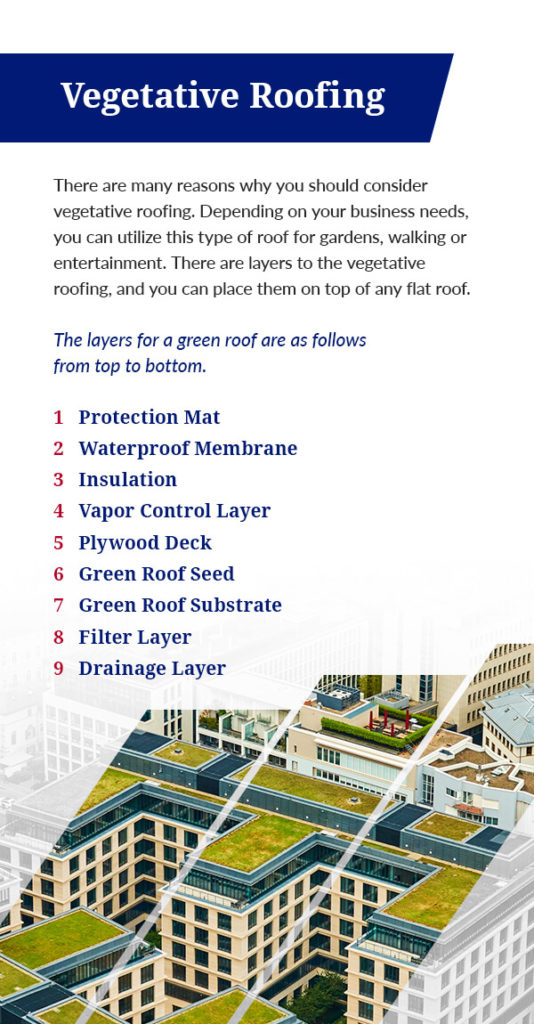
There are many reasons why you should consider vegetative roofing. It provides extra space for plant life, research or whatever you desire. There are different types of options for a green roof. One option is intensive green roofs. These green roofs are the most popular among the four choices. Depending on your business needs, you can utilize this type of roof for gardens, walking or entertainment. You can only install this type of roof on flat roof commercial businesses.
Another option for your vegetative roof is a brown roof. These roofs help local environmental issues and specific ecosystem issues, such as providing food to a local species. They are not so much for the people of the business as they are for the environment itself. Although, brown roofs still help with your overall roof heat and lowering energy costs.
Semi-Intensive green roofs are much like intensive green roofs. Semi-Intensive roofs are a bit shallower, supporting bushes and grass instead of a whole garden or trees. They are slightly more versatile and can be set up on low-slope and flat roofs since they are generally not to walk on.
The final type of vegetative roofing is the extensive green roof. These are generally a lot shallower than the previous styles and are made for moss or other small forms of vegetation instead of deep-rooted systems. There are layers to the vegetative roofing, and you can place them on top of any flat roof. The layers for a green roof are as follows from top to bottom.
- Protection Mat
- Waterproof Membrane
- Insulation
- Vapor Control Layer
- Plywood Deck
- Green Roof Seed
- Green Roof Substrate
- Filter Layer
- Drainage Layer
Interior Temperatures
The material and roofing style you decide on also dictates the temperature in the interior of your building. If you are in a warmer area, using a white coating on your roof no matter the material will help reduce AC requirements and lower the overhead cost for energy. As mentioned above, providing the roofing of your building with a green roof over the top of the main roof will help reduce heat absorbed even more.
You will need to maintain the roof by keeping it clean, re-paint it if required and continuing roof maintenance every ten years. Regular inspections will keep you updated on your roof condition and any possible repairs or re-roofing that you will need to do. If your roof is TPO, PVC, EPDM or a green roof, you will notice a difference in building temperature control between those and rooftops constructed from unpainted metal or a black roof.
The heat absorbed by a roof radiated inside, especially for older buildings that may not meet current insulating standards. While newer roofs are more efficient, the material, style and color still directly influence the interior temperature of your building. Changing the color of your roof can minimize heat transfer and help make your air conditioning more efficient, reducing energy costs.
Roof Temperatures
You can count on average temperatures for how hot your roof is based on 90-degree weather. Having this information will help you decide what type of roofing is best for your commercial business. Two factors are in play when thinking about the heat of your roof, including how much the material absorbs and how much it reflects the heat into the atmosphere.
The heat of a commercial roof’s ability to reflect the sun’s energy is a metric known as solar reflectance. On the other hand, thermal emittance is the term given to the summer temperature of a commercial roof by the amount of heat the roof material rejects rather than absorbs. Solar reflectance and thermal emittance are measured on a scale from 0 to 10, with higher scores reflecting cooler roofs. Some of the average temperatures of roofs by material type include:
- Black roof: 140-190 degrees
- Aluminum reflective coating: 73-123 degrees (always up to 70 degrees cooler than black roofs)
- Gravel roof: 125-140 degrees
- Unpainted metal: 138-145 degrees but feels much hotter when you touch it
- Painted metal: 105-115 degrees
- White roofing: 102-120 degrees
- Vegetative (green roofing): 90-degrees
Should You Get a New Roof?
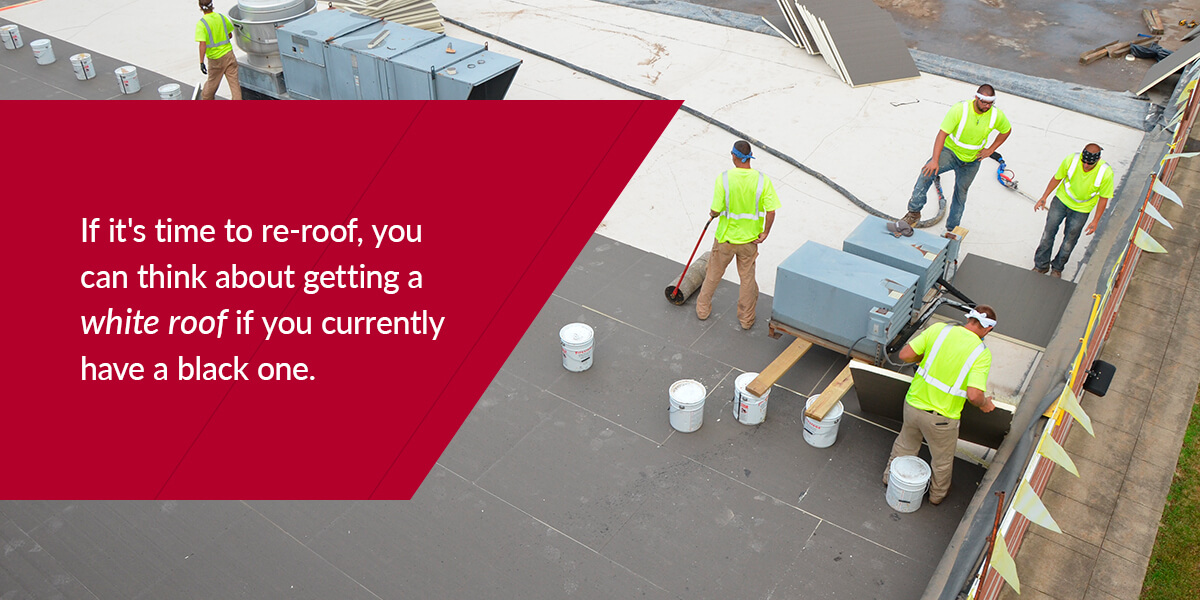
Now you are thinking, should I get a new roof to lower energy costs and control interior heat by having a roof that dissipates and reflects heat? You have some control over how hot your roof gets in the summer by taking specific measures. If it’s time to re-roof, you can think about getting a white roof if you currently have a black one. There is also some coating technology that can help.
You could also have some fun and build a green roof on top of whatever current roofing you have! Not only will the green roof lower how hot your commercial roof is, but it adds style to your building! If you are in the process of construction and decide which type of roof you need for your business, you now have more knowledge to make a proper decision.
Get Your Free Quote and Inspection From David Maines & Associates, Inc.
David Maines and Associates are experienced, knowledgeable and reliable. Are you thinking about one of these great options mentioned above for your roof or needing current roofing redone? Now you know more about the different roofing styles and how they correlate with heating distribution and absorption, you can decide what option works best for you!
We are proud to offer commercial roofing services, including roof replacement, roof restoration, repair, and maintenance. Our team also provides commercial masonry, commercial wall panel and commercial waterproofing. With decades of experience, we are a leading commercial roofing contractor, having worked with large businesses, schools, government agencies and more. To get started with a free quote and inspection, contact us online or call 717-248-3070.
Share
